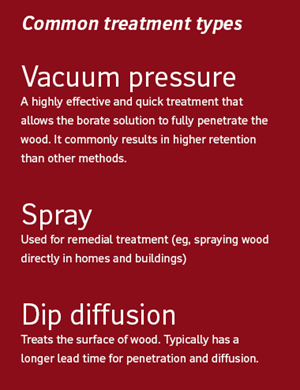It’s clear why wood remains a top choice among construction materials. Wood is:
- Strong
- Durable
- Sustainable
- Efficient
- Available to source locally
- Less expensive than alternative building materials
However, wood is also vulnerable to threats such as fire, moisture, and harmful organisms. These actors can quickly destroy or slowly decay wood’s integrity over time, resulting in costly repairs.
The best form of damage prevention is effective protection. For years, companies have used borate wood treatments as a trusted safeguard.
Still, questions remain on how to properly protect wood with borates. And the stakes are high: Ensuring the correct treatment upfront is critical, as it can save substantial time and money.
Effective protection involves three important facets:
- Understanding your environment
- Developing the right borate concentration for treatment
- Working with an experienced partner
Borate wood protection: Where to start?
Start by considering your end use and environment. Grasping this basic information will help you select the right product and tailor treatment to match your needs.
Environment
Climate conditions such as humidity and moisture levels dictate which natural enemies your wood will be susceptible to—whether that’s insects, fungi, or moisture. The greater your understanding of wood-destroying elements and organisms, the likelier it is you’ll get an effective treatment.
For example, if you’re in a climate where subterranean termites are present, a higher level of borate concentration and retention is necessary to prevent damage.
Use conditions
Ask yourself: What is the final use for your wood products? Will the finished product be used for the interior or exterior? Will it make ground contact? Is it going to be weather protected?
We recommend consulting the American Wood Protection Association’s Use Category System (UCS) to help you outline treatment needs based on the end use of wood products. This system also will help you understand key considerations such as required retention levels, which is expressed in pounds of preservative per cubic foot (PCF).
Once your application is known, you can select the right type of borate product (soluble or insoluble). For example, a soluble borate product such as Tim-bor® (disodium octaborate tetrahydrate) is only recommended for above ground, interior applications.
Developing the right borate wood treatment
 The first step is to determine your wood’s absorption and diffusion capacity. Applying a water solution first—without borates—helps account for variations in wood species, product type, as well as any quality issues or defects.
The first step is to determine your wood’s absorption and diffusion capacity. Applying a water solution first—without borates—helps account for variations in wood species, product type, as well as any quality issues or defects.
Afterward, you’ll know the necessary borate solution strength, or concentration, your wood needs to reach the targeted retention.
Note: Not all borate products have the same amount of boric oxide (B2O3) content. Tim-bor has the highest boric oxide content, which means it can be used at a lower concentration. Depending on the product you select, you may need to calculate the boric acid equivalent (BAE) from B2O3 content.
After treating your wood, it’s important to check boric oxide retention in the wood. A good treatment reduces the risk of soluble borates (boric acid, borax, Neobor®, and Tim-bor) leaching out, leaving wood unprotected and vulnerable to wood-destroying organisms.
To run a quality check, you can spray a curcumin-based solution, prescribed in the AWPA A68 standard. When the solution detects boron, it will turn a pink or red color, showing how it has penetrated and distributed in the wood.
Or, to test at a larger scale, an elemental analysis can be performed to measure borate retention. Weighing a dried sample before and after treatment allows you to calculate retention based on the wood’s density.
Work with the right partner
With so many variables to account for, it helps to have a trusted partner such as U.S. Borax to ensure the right treatment for lasting, effective protection.
For decades, manufacturers have trusted our products because they maintain a high level of quality, reliable chemical consistency, and are easy to use.
If you have any questions about your specific use case or environmental factors that may affect treatment, we can help.
Our technical support team can answer questions, provide access to research papers on protection efficacy against various organisms, and give supplemental guidance to information found in the AWPA Book of Standards.
Resources